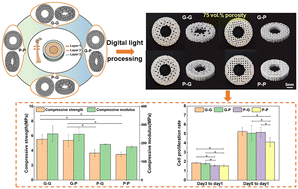Design and fabrication of biomimicking radially graded scaffolds via digital light processing 3D printing for bone regeneration
Abstract
Scaffolds are an essential component in bone tissue engineering (BTE). However, most of the current BTE scaffolds are homogeneous structures and do not resemble the graded architectures of native bone. In the current study, four types of biomimicking scaffold designs based on gyroid (G) and primitive (P) units with radially graded pore sizes were devised, and scaffolds of these designs with two porosity groups (65 vol% and 75 vol%) were fabricated via digital light processing (DLP) 3D printing using biphasic calcium phosphate (BCP). Scaffolds of the gyroid–gyroid (G–G) design displayed better dimensional accuracy, compressive property, and cell proliferation rate than gyroid–primitive (G–P), primitive–gyroid (P–G), and primitive–primitive (P–P) scaffolds. Subsequently, graded G–G scaffolds with different porosities were fabricated and the relationship between compressive strength and porosity was determined. Furthermore, the sintered BCP bioceramics fabricated via current manufacturing process exhibited excellent biocompatibility and bioactivity, indicating their high potential for BTE.

- This article is part of the themed collection: #MyFirstJMCB


 Please wait while we load your content...
Please wait while we load your content...